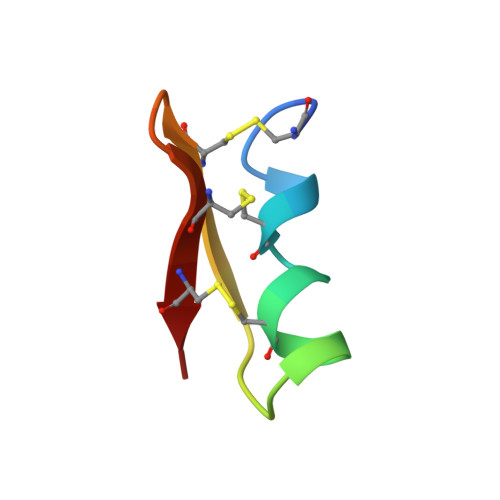Transfer of a beta-hairpin from the functional site of snake curaremimetic toxins to the alpha/beta scaffold of scorpion toxins: three-dimensional solution structure of the chimeric protein.
Zinn-Justin, S., Guenneugues, M., Drakopoulou, E., Gilquin, B., Vita, C., Menez, A.(1996) Biochemistry 35: 8535-8543
- PubMed: 8679614
- DOI: https://doi.org/10.1021/bi960466n
- Primary Citation of Related Structures:
1CMR - PubMed Abstract:
The alpha/beta scorpion fold is shared by scorpion toxins, insect defensins, and plant thionins. This small and functionally versatile template contains an alpha-helix and a triple beta-sheet linked by three disulfide bridges. With the view to introduce novel functional centers within this fold, we replaced the sequence (the cysteines and glycines excepted) of the original beta-hairpin of a scorpion toxin by the sequence of a beta-hairpin that forms part of the site by which snake neurotoxins bind to nicotinic acetylcholine receptors (AcChOR). The resulting chimeric protein, synthesized by chemical means, binds to AcChOR, though with a lower affinity than the snake toxins [Drakopoulou; E., Zinn-Justin, S., Guenneugues, M., Gilquin, B., Ménez, A., & Vita, C. (1996) J. Biol. Chem. 271, 11979-11987]. The work described in this paper is an attempt to clarify the structural consequences associated with the transfer of the beta-hairpin. We report the determination of the three-dimensional solution structure of the chimeric protein by proton NMR spectroscopy and molecular dynamics calculations. Comparison of the structure of the chimera with those of the scorpion alpha/beta toxin and of the snake neurotoxin shows that (i) the new protein folds as an alpha/beta motif and (ii) the beta-hairpins of the chimera and of the curaremimetic toxin adopt a similar conformation. A closer inspection of the differences between the structures of the original and transferred beta-hairpins allows rationalization of the biological properties of the chimera.
Organizational Affiliation:
CEA, Département d'Ingénierie et d'Etude des Protéines, Gif-sur-Yvette, France. szinn@balthazar.saclay.cea.fr














